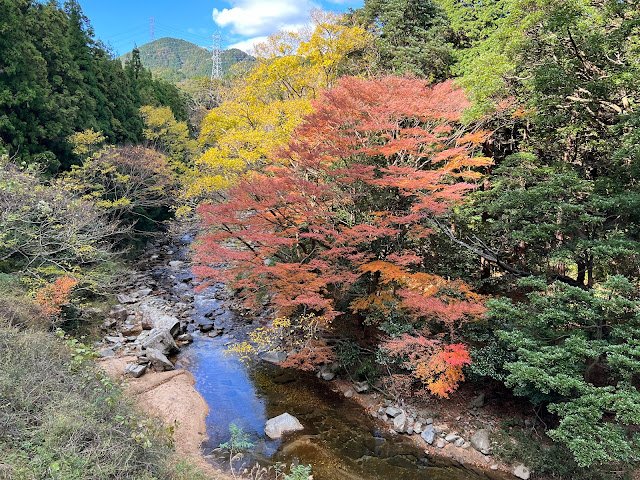More train travails after checking out of the Kaneyama hotel: partly another case of confusion over when to ‘tap off’ with the IC card, and partly because of delays on the line out of Nagoya. As a result, it was nearly 10.30 by the time I set off walking from little Seki station.
Much of the early part of the walk was alongside Route 1 as it climbed gently into the hills, although there was an occasional diversion onto the old road through villages to provide a respite from the traffic. Autumn colours are much more evident now, particularly on bright days like today.
At Sekichokutsukake, an old Western-style school building had been converted into a “Youth Nature House”, just over the road from a geodesic structure that I think was part of the same complex.
Things Japan does surprisingly badly (No.2 in a very short series): Children’s playgrounds. This spot, where I paused for a rest and to finish the mandarins very kindly given to me by Yoshiko-san back in Chiryu, is far from unusual: a scrubby patch of grass and a few poorly maintained pieces of equipment that look like they date from the 1970s. Out of shot are a couple of frames for swings that lack chains and seats.
Anyway, rested and refreshed, I continued walking. The valley narrowed…
… and at last I turned off Route 1 onto a track and began climbing towards Suzuka Pass.
There was even a short stretch of ishidatami for old time’s sake.
Under the Route 1 overpass…
… up a flight of stairs and onto a steep but beautiful forest track that before too long arrived at the crest of the pass. Although nowhere near as high or as challenging as Hakone Pass, it had been enough of an effort with a semi-heavy pack on my back to make it feel like a minor achievement. This is the last pass on the Tokaido (for those heading to Kyoto).
Just beyond the summit of the pass, overlooking the valley on the western side, is this large and roughly hewn stone lantern, presumably of purely symbolic value.
And a little beyond that is the sign marking the entrance to Shiga prefecture, not quite the last one I’ll be visiting on this trek.
In terms of scenery, there was little of note on the rest of today’s walk, much of which was on Route 1 and not particularly enjoyable. One oddity was the lack of convenience stores. I’ve become so conditioned to seeing a konbini every few kilometres (at least), that I’ve become lazy about planning for food, assuming I’ll be able to find something cheap and reasonably wholesome when I need it. Today, I don’t think I passed a single konbini between Seki and the outskirts of Koka. By the time I got to Tsuchiyama, I was desperate – and therefore ecstatic to see a simple roadside place selling takoyaki – or octopus balls.
The owner, Yoko-san, asked where I was from, and when I showed her my introduction she insisted on taking a picture of both it and me and said she would post them on Instagram. I’m going viral in Japan!
Of far more immediate interest to me was the chance to eat something hot (very, very hot) and incredibly tasty. I could have eaten another half-dozen, and probably should have.
By the time I got to Minakuchi–Ishibashi, the sun had long set and my head torch was lit front and back. I had to wait 40 minutes for a train while the temperature kept dropping, and then needed to change onto another line at Kusatsu for a second train on to Otsu and my new hotel. Unfortunately, I messed up the change at Kusatsu and got on a train leaving at the right time … but in the wrong direction. Off at the next stop, up and over to the other platform, train back to Kusatsu, wait again for (this time) the right train…
Long and short of it is that it was nearly 9 o’clock when I checked in at the Lake Biwa Otsu Prince Hotel. I knew it would be a step up in quality from the business hotels I’ve been staying in until now, but hadn’t realised that it would be a 40-storey resort-style tower on the shore of the lake. Very fancy, I thought, as the taxi dropped me off and the concierge held the door open for me. Things only got better when the front desk told me that (for a reason that may have been communicated but I missed) they’d upgraded me to a suite. My new digs have a large bedroom, a bathroom that’s bigger than some of the bedrooms I’ve been staying in, and a large lounge area with amazing views over the lake. From the bedroom – and even from the bathroom, should you so desire – there are views over the city.
Another pleasant shock came when I looked at the map to check how far I was from Kyoto, and realised I had less than 50 km to go. Given the distances I’ve been covering and the fact that there are no big hills between Minakuchi–Ishibashi and my final destination, I should be able to cover that in two days. That would have me arriving in Kyoto on 3 December – four days ahead of schedule. I’m very happy with that.














Comments
Post a Comment